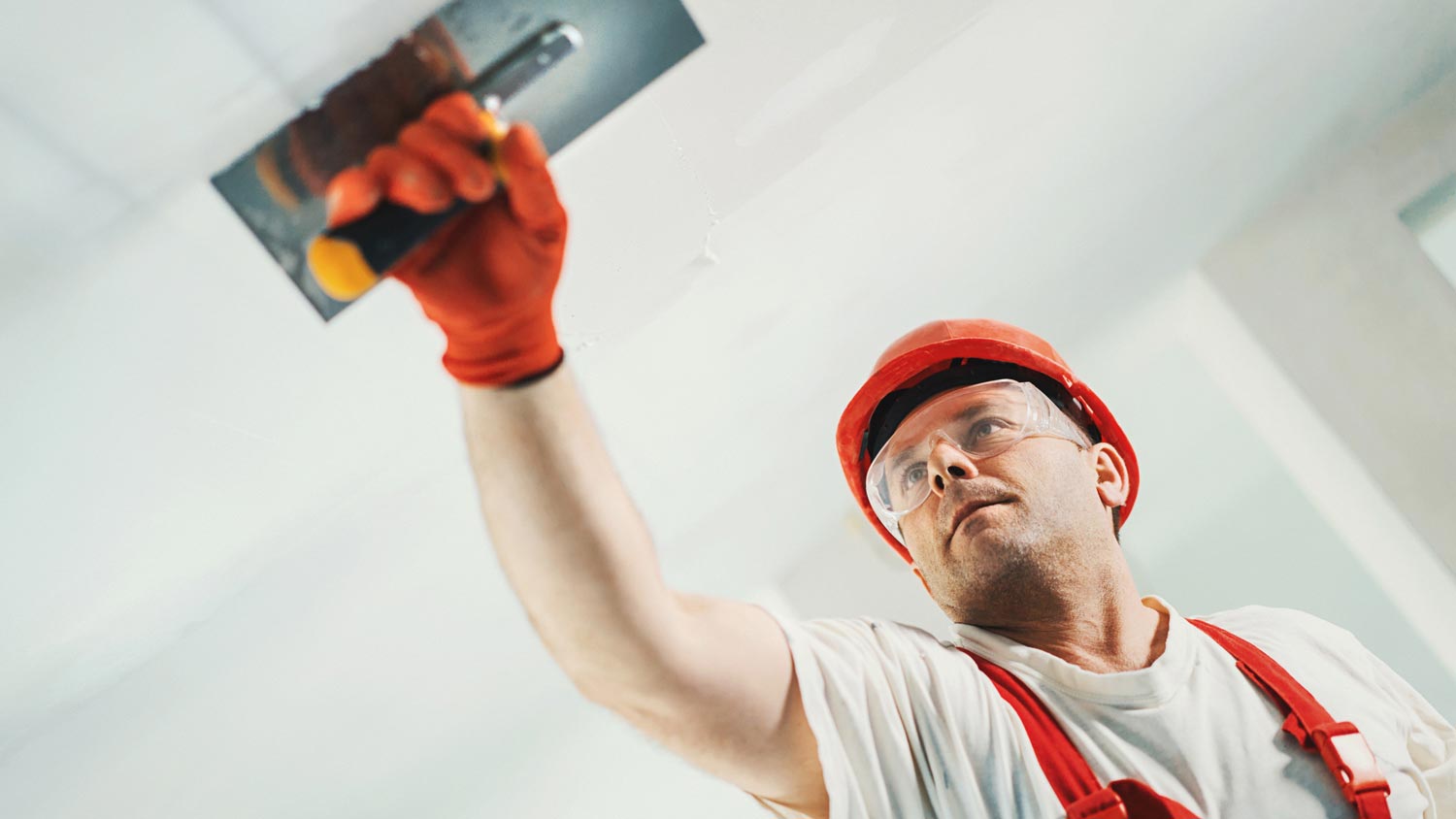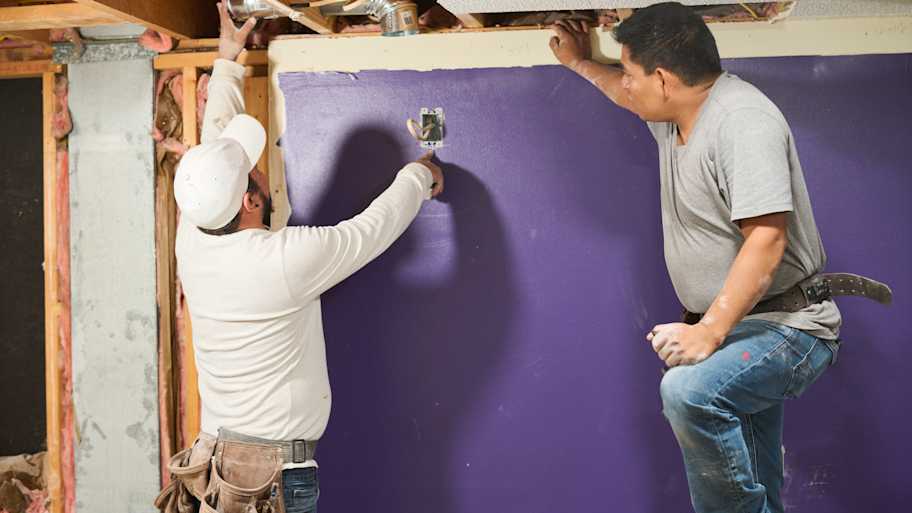Can You Drywall Over Plaster? And Should You?
The charm of plaster versus the clean look of drywall


Placing drywall over plaster is possible.
You must secure drywall to wall studs with screws.
Finding wall studs behind plaster can be challenging.
Weigh the pros and cons before putting drywall over plaster.
Older homes have plenty of history and character, along with a few quirks that make people initially fall in love with them. However, not all quirks end up being charming once you start living with them on a daily basis. If one of your home’s quirks involves plaster walls that are starting to look rough, you may wonder, can you drywall over plaster? You can, but you may not want to—without a compelling reason—because of the expense and drawbacks.
If you're purchasing an older home, think twice about replacing—or covering—plaster with drywall. While plaster may seem outdated or high maintenance, it's a longer-lasting material overall.
Can I Drywall Over Plaster? The Answer
Yes, you can drywall over plaster, but whether you should or not involves weighing the pros and cons. Below are some questions you should ask yourself before you decide if you will drywall over plaster.
What Is the Cost?
The average cost to replace plaster with drywall is more than simply installing drywall over existing plaster. The average cost to install drywall is about $2,000, but it can significantly increase for a large square footage job. A local drywall contractor can give you an estimate for the cost of your particular project.
However, if you want to rip out your plaster and install drywall directly on the wall studs, the demolition costs will add to the overall cost of the job. The cost to remove a wall can range from $300 to $10,000 (on the lower end for non-load bearing) before you add the cost of installing drywall. You can save money by skipping demolition and covering your existing plaster with drywall.
You may decide that the cost to install new drywall over your plaster walls isn’t worth it if your plaster walls are in good shape.
Does Your Plaster Wall Need Repairs?
Plaster repair cost typically ranges between $22 to $30 per square foot to fix holes and cracks. Some types of damage may cost even more to fix. A local plaster repair company can give you an accurate estimate.
If the estimated cost to repair your plaster is high, it may be worth it to cover it or replace it with drywall instead. Get cost estimates for both options to help you make a decision.
Will It Increase the Thickness of Your Walls?
Although you can drywall over plaster, you will slightly increase the wall thickness by doing so. Drywall sheets are available in thicknesses between one-fourth and three-fourths of an inch. Most rooms in a home will use drywall with a thickness of one-half of an inch. However, since you’re drywalling over plaster, you may be able to use one-fourth of an inch thick drywall successfully.
By hanging the drywall over the plaster, you shrink the size of the room by the thickness measurement of the drywall. Granted, it’s a tiny amount, so you may not notice it.
However, the additional thickness of the wall will affect how your window and door trim appears, requiring you to remove and reinstall the trim or use expansion pieces. You may have to adjust your power outlets with extensions to accommodate the extra thickness.
Are You Concerned About a Mess?
Instead of tearing out an old plaster wall, you could save quite a bit of mess by hanging drywall over the existing plaster wall instead.
Removing plaster does produce significant dust and loose chunks of plaster and lath. However, by placing new drywall over your plaster, you won’t have to deal with a big mess.
Will You Replace or Repair Plumbing and Electrical Soon?
If you will replace your electrical and/or plumbing in the near future, you may want to wait to make any decisions about drywalling over plaster until that work is completed.
If you prefer drywall, you should install it after you tear holes in your walls for electrical or plumbing work. You could put drywall sheets over the plaster and cover the holes.
You may also choose to tear out all the plaster at that time and put up new drywall. Or, you could simply repair the plaster instead of adding drywall. Weigh all of your options and get cost estimates and advice from the pros to help you decide.
Do You Want a Clean Look and Flat Walls?
A drywall installation generates a clean, modern look inside your home. Plaster can have tiny cracks, or it may crumble as it ages. Plaster walls can have some slight curves in them, too. You don’t typically get this look with drywall.
Some people prefer the imperfect look that plaster provides in an older home, feeling it enhances the home’s charm. However, if you prefer flat and square walls, drywalling over plaster may be the way to go.
Basic Techniques to Hang Drywall Over Plaster
Before trying to drywall over plaster, it’s helpful to understand the differences between plaster and drywall.
Drywall is available in sheets that attach with screws over a framework of two-by-four wall studs. This creates a sturdy base for the sheets of drywall.
Plaster is a paste that attaches to lath inside the walls. Lath consists of narrow strips of wood that attach to wood studs inside the wall or to ceiling joists. The plaster uses the lath for a base until it can dry and harden, forming the visible part of the wall.
As long as you can find the studs under the plaster, you can hang drywall by screwing the sheets to these studs. Be sure to use screws that are long enough to go through the drywall and plaster to reach the studs.
Can you put drywall over paneling the same way? Yes, because as long as you can screw the drywall sheets securely to wall studs, you can hang drywall over almost anything.
Drywalling Over Plaster
In a modern home, building codes require the wall studs to be 16 inches apart on center, which means there are 16 inches from the middle of one stud to the middle of the next stud. Consequently, you always know where the studs are, even when they’re hidden behind drywall.
In an older home with plaster walls, though, you don’t necessarily know where the studs are. Before modern building codes went into effect, builders frequently used distances of 16- or 24-inches on center for studs in older homes. Occasionally, builders of older homes used different measurements from room to room.
This complicates the process when you drywall over plaster.
Finding Wall Studs Under Plaster

You can use an electronic stud finder to locate the wall studs behind the plaster. If the plaster is especially thick, though, a stud finder may not work accurately.
If it doesn’t work, you can try a few things, like striking the plaster with your knuckles to detect studs if you hear a solid sound versus a hollow sound. If you have electrical outlets in the room, these should sit on one side of a stud.
Since you will be placing sheets of drywall over the plaster, you can test the locations that you think contain wall studs. Use a drill with a narrow bit to go through the plaster and see if you hit a wood stud. You will then know where to screw the sheets of drywall to attach them to the wall studs.
You don’t have to worry about the tiny holes you made in the plaster with the drill because you won’t see them behind the drywall.





- Plaster vs. Drywall: Pros, Cons, and Costs
- Drywall vs. Plaster: How to Tell Which Walls Are in Your Home
- What Is Behind Your Lath and Plaster Walls?
- Why Do Plaster Walls Crack?
- How Long Does Plaster Take to Dry?
- Can You Paint Over Plaster Walls? Yes, But Take These Steps First
- Types of Plaster and Use Cases for Each
- Is Insulating Plaster Walls a Good Idea?
- 7 Types of Plaster Finishes for Interior Walls
- The DIY Guide to Easily Fix Cracks in Your Plaster Wall











